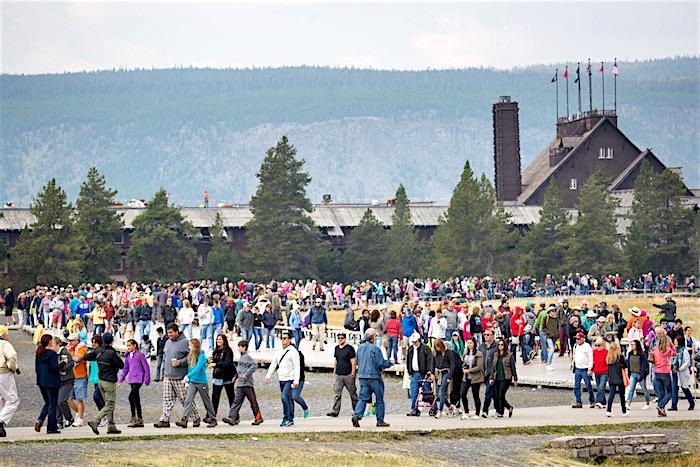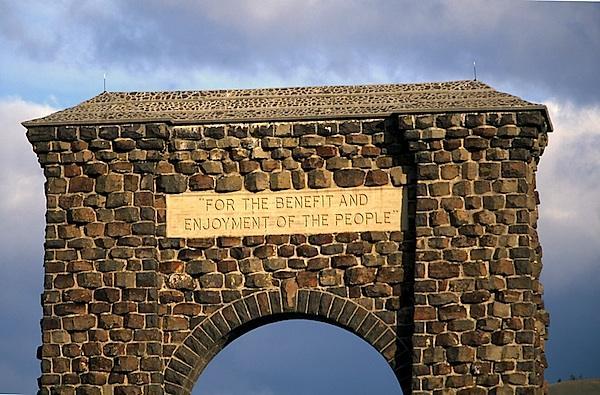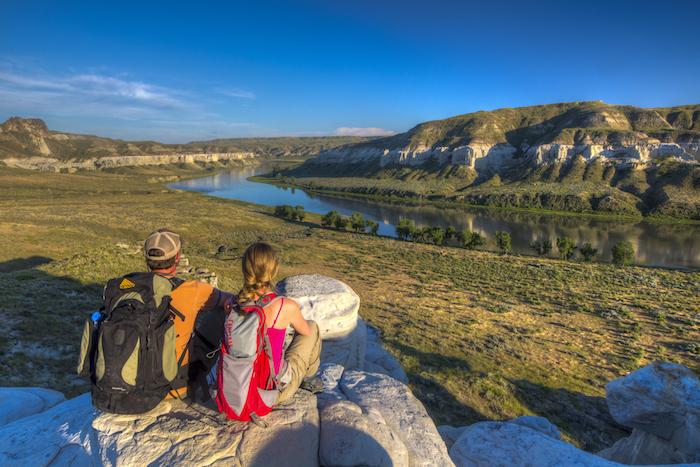
Crowds in national parks were an issue in the 1960s and remain so today/NPS
The conundrum was as obvious in 1967 as it is today: "Of all the conservation and management problems facing the National Park System in 1967, balancing the claims of rapidly mounting public use and the requirements of preservation is probably the most pervasive and difficult."
So wrote Ronald F. Lee, a special assistant to National Park Service Director George Hartzog, in 1967 while looking at Public Use of the National Park System between 1872, when Yellowstone National Park was created, and 2000.
Mr. Lee's 98-page analysis was overly predictive in some areas -- "The growth rate for National Park System travel is such that a travel year of one billion by 2000 no longer appears fantastic." -- but also forewarning in others.
"... there is the commercial exploitation of genuine values," he wrote. "The offensive multiplication of hot dog stands, tourist traps of all kinds, fake museums, and other money making enterprises near or in areas of serious importance becomes in some cases a public disgrace. It remains true that within the boundaries of the National Park System commercialism is at a minimum and this is now, and has always been, one of the System's basic objectives. The Vatican Congress warned developing countries where tourism is rapidly expanding of the necessity of protecting themselves 'against the psychological and moral degradation which may arise from a mercenary tourism,' and of 'defending in all the sense of a personal and national dignity.' This warning would be equally appropriate for developed countries, including the United States."
Strong words. And some would argue not always adhered to since they were written down. The late Dr. Michael Frome long lamented the commercialism of national parks, warning that it would turn them into "popcorn playgrounds."
The conflicts in the National Park System that Mr. Lee highlighted 51 years ago are, at the end of the day, virtually identifical to what the National Park Service is trying to cope with today. He mentions the need for carrying capacities for parks, and warns of the problems too many people in the parks can create.
"We are all familiar through personal experience with many obvious objections to unregulated tourism. Some objections relate to the quantity of tourist travel, and involve mounting traffic volume with concomitant increase in parking problems, highway accidents, traffic snarls and jams, bent fenders, noxious exhaust gases, honking horns, crowded accommodations, waiting in long lines, and a hundred small and large irritations and frustrations associated with automobile touring, especially at peak periods," he wrote. "Some of these objections relate to the quality of the touring experience and may involve views that 'many persons are not mentally prepared properly to appreciate parks and historic sites;' 'tourists are anonymous mass travellers;' and that the experiences most tourists have are 'superficial and routine.'"
Speed forward to the 21st century and we have superintendents lamenting that they need to teach visitors how to behave in parks, more talk of carrying capacities, and visitors complaining about their experiences.
What's on the horizon?

Balancing the public's enjoyment in national parks with conservation of resources has been a longstanding issue/NPS
More efforts to expand Wi-Fi coverage in the National Park System; calls to expand campgrounds, if not add more; possibly create more access in parks; and, perhaps, even build more lodges. And each of those steps carries along with it more commercialism and encounters what Mr. Lee referred to as "the perennial problem of balancing preservation and public use in the National Park System..."
Interior Secretary Ryan Zinke hasn't revealed all his plans for the parks, but he has shown himself to be more determined to open up public lands for resource extraction than to protect them for future generations. He has created an advisory committee to suggest ways to "expand recreational access to public lands and waters," has said he doesn't believe the Park Service can adequately run campgrounds, and has been courted by the private sector that's interested in gaining more business opportunities on public lands in general and the National Park System specifically.
Recently a collaborative organization representing the outdoor industry, motorized recreation interests, RV groups, and even the shooting sports sector released a position paper that identified four key goals:
* Ensure recognition of the primary outdoor recreation economic drivers in the U.S.
* Foster federal collaboration that will enable the outdoor recreation economy to reach its full potential.
* Remove barriers that prevent private investment from being made on public lands and waters.
* Change the mindset of federal agencies so recreational access and high-quality visitor experiences are prioritized.
The end goal? More commercial opportunities and more access.
In an article the other day, the Center for American Progress identified five individuals it thought had the greatest sway on Interior Secretary Zinke. The five, the article stated, "have played an outsized role in influencing Zinke’s embrace of a far-right, transactional approach to government land management."
When it comes to gaining more private-sector opportunities in the National Park System, the group zeroed in on Derrick Crandall, the "CEO of the American Recreation Coalition, a group focused on 'catalyz[ing] public/private partnerships to enhance outdoor recreation opportunities.'”
Mr. Crandall, who also is counselor to the National Park Hospitality Association that represents many park concessionaires, "appears to be catering to a subset of so-called recreation groups that loosely support the privatization of national parks and public lands for profit. This shift of what constitutes outdoor recreation could have negative impacts for hunters, hikers, bikers, campers, and anglers," the article said.
Mr. Crandall does see opportunities for the groups he represents in the National Park System, and maintains that the Park Service will never get an adequate budget from Congress to adequately manage the parks and so needs outside help.
“We just see a return to a philosophy of partnerships," he said during a wide-ranging phone conversation last week, pointing to state and federal governments agencies as well as private business and park friends groups. "We’ve had lip service to that partnership model for years. We’ve had some people in some agencies that have been promoting that, but I really think, at its heart, agencies like the Park Service, have really hoped that they could just get the resources to do the whole job themselves and not have to worry about working in a shared responsibility role.
"It’s just not going to happen. The resources are not there.”
Mr. Crandall shares one point with Mr. Lee: Overcrowding in parks can be handled in part by dispersing crowds not just within parks but to other neighboring public lands, such as national forests, wildlife refuges, and areas managed by the U.S. Bureau of Land Management.

Getting travelers to divert from national parks to other public lands, such as Upper Missouri Breaks National Monument, could help reduce the tourism pressure on parks/BLM, Bob Wick
"A favorite idea for relieving pressure of public use on the National Park System, particularly the national parks, is to develop more recreation facilities in state parks, national and state forests, reservoir and other recreation areas to take up the visitor load," wrote Mr. Lee.
Agreeing with that approach, Mr. Crandall crafts it in a way to increase business for the private sector.
"Many of those (other public) lands have the same kind of allure that national park units have, just in terms of physical features and other kinds of things," he said. "Plus, in many cases they have activities that are not allowed and are inappropriate in national park settings. But what they’re missing would be the kinds of infrastructure like campgrounds and lodges and other kinds of things that would make those more attractive to, and more usable by, 21st century Americans. And BLM has no clear authority to partner in developing those kinds of facilities under a concessions model.”
Turning back to the National Park Service, Mr. Crandall perhaps cracked the window on the conversations he's had with Secretary Zinke. National parks need larger and improved campgrounds with more conveniences, he said, and for the most part the existing lodging infrastructure in the park system is in poor shape.
"In general, the Park Service has been very, very discouraging about the investments needed to bring the current infrastructure up to modern kinds of levels or to expand and we think those deserve to be looked at and changed," he stated.
In that regard, Mr. Crandall diverges from Mr. Lee's thoughts.
"The National Park Service is parent of the concept of eliminating overnight accommodations (except campgrounds) inside the parks to minimize intrusions and lessen impact," Mr. Lee wrote back in 1967. "Lately, this idea has been taken up by others who now claim it as a new concept. The principle of eliminating overnight accommodations was first applied over thirty-seven years ago in plans for the Great Smoky Mountains National Park. Except for Le Conte Lodge, no overnight accommodations, except 66 campgrounds, have been permitted in the park since it was established in 1930.
"This same idea was subsequently adopted for Acadia National Park, Cape Hatteras, and Cape Cod, among other places. Has this policy solved the (crowding) problem? Undoubtedly it has reduced construction of buildings in the parks and lessened some kinds of physical intrusion," wrote Mr. Lee. "It must also be noted, however, that by this policy noncamping visitors are denied the cycle of the day and night in a supreme environment because there are no overnight accommodations for them.
"The National Park Service and the visitors have accepted this sacrifice as necessary."



Comments
Maybe, just maybe, if we can survive the Trump swamp, there will be a chance in the future of reversing at least some of the damage he and his fellow morons will do.
Just reading the list of those who seem to have serious influence on Zinke was frightening. Especially when Mike Noel's name popped up there.
In the meantime, people who care about the future of our country -- and not just short-term profiteering -- need to be ready to fight to protect precious places, people, and things until the Trumpian era finally ends. It's going to require a lot of effort, lawsuits, and donations to organizations that can help.
Let's hope we can do it.
I think what's important to note, Lee, is the timeframe. Fifty years. That covers a lot of administrations/Congresses on both sides of the aisle.
Yes, it does. But at no time in the past have we had an administration so intensely crooked and bent on upending so much of what has made America the fine nation it is. Until last year, most of the problems facing our parks were the result of neglect. Now they are under active attack.
I believe the Centennial Act gave the NPS a new authority - the "Visitor Experience Improvement Authority" to make improvements and provide commercial services without having to award a conecssion and be crippled by things such as leasehold surrender interest. I believe it is true that stand-alone campgrounds in NPS units aren't profitable. The campground needs to be teamed up with another type of conecssion (lodge, snack bar, etc) in the same park for there to be a profit. Just saying turn over campgrounds to the private sector isn't the answer for everything.
There are already many campgrounds run by concessions in the parks across the system. I don't think anyone in the NPS oppposes that idea outright. It has been a model since the NPS was created.
One great model of partnerships for a campground is the Schoodic campground up at Acadia. It was all built by the private sector and on private land adjacent to Schoodic and when completed it was donated back to the NPS to operate. You can get a great experiecne and avoid the Bar Harbor crowds. It is very nice and done in partnershipw with the NPS.